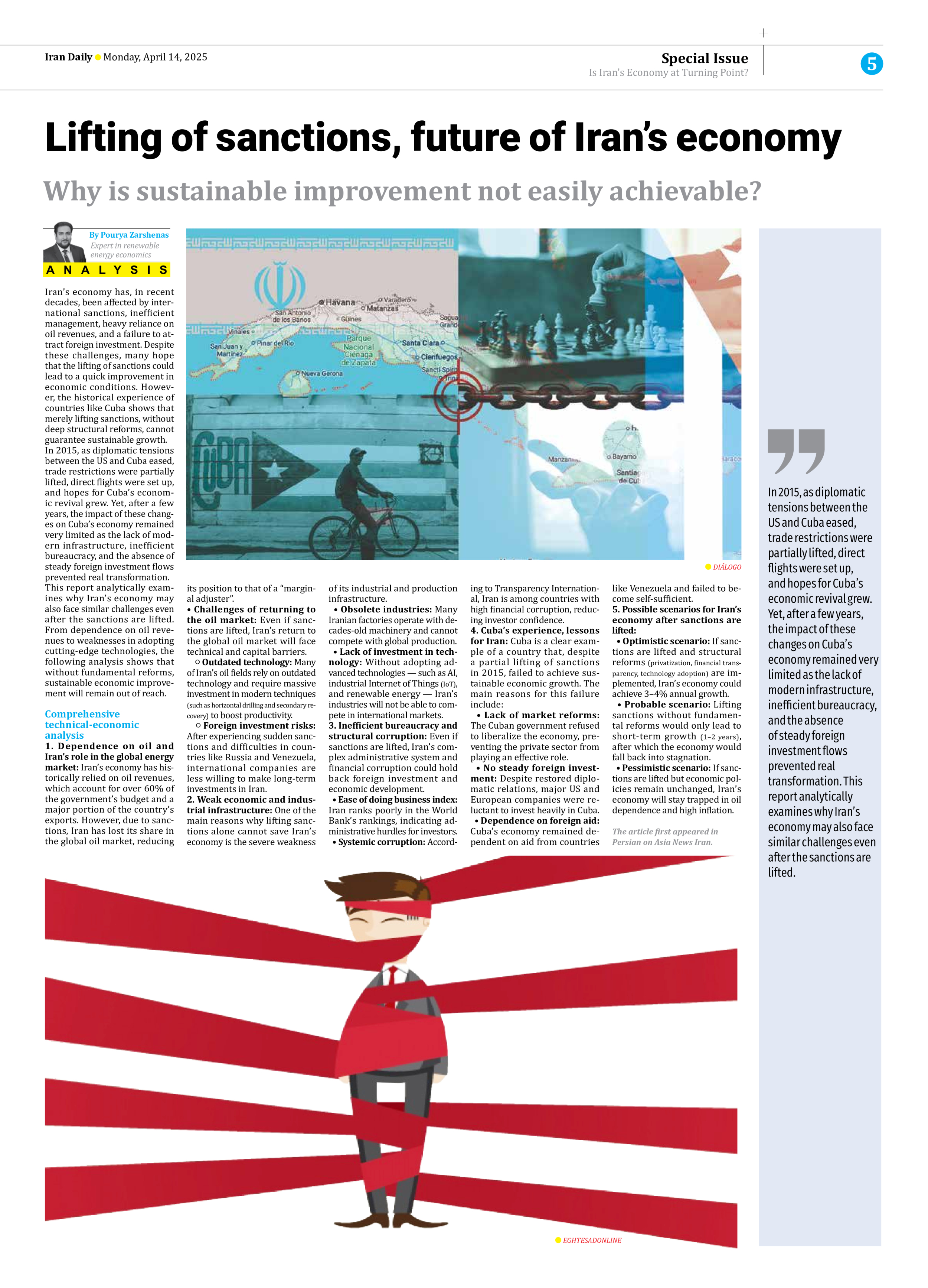
Lifting of sanctions, future of Iran’s economy
Why is sustainable improvement not easily achievable?
By Pourya Zarshenas
Expert in renewable energy economics
Iran’s economy has, in recent decades, been affected by international sanctions, inefficient management, heavy reliance on oil revenues, and a failure to attract foreign investment. Despite these challenges, many hope that the lifting of sanctions could lead to a quick improvement in economic conditions. However, the historical experience of countries like Cuba shows that merely lifting sanctions, without deep structural reforms, cannot guarantee sustainable growth.
In 2015, as diplomatic tensions between the US and Cuba eased, trade restrictions were partially lifted, direct flights were set up, and hopes for Cuba’s economic revival grew. Yet, after a few years, the impact of these changes on Cuba’s economy remained very limited as the lack of modern infrastructure, inefficient bureaucracy, and the absence of steady foreign investment flows prevented real transformation.
This report analytically examines why Iran’s economy may also face similar challenges even after the sanctions are lifted. From dependence on oil revenues to weaknesses in adopting cutting-edge technologies, the following analysis shows that without fundamental reforms, sustainable economic improvement will remain out of reach.
Comprehensive
technical-economic analysis
1. Dependence on oil and Iran’s role in the global energy market: Iran’s economy has historically relied on oil revenues, which account for over 60% of the government’s budget and a major portion of the country’s exports. However, due to sanctions, Iran has lost its share in the global oil market, reducing its position to that of a “marginal adjuster”.
• Challenges of returning to the oil market: Even if sanctions are lifted, Iran’s return to the global oil market will face technical and capital barriers.
○ Outdated technology: Many of Iran’s oil fields rely on outdated technology and require massive investment in modern techniques (such as horizontal drilling and secondary recovery) to boost productivity.
○ Foreign investment risks: After experiencing sudden sanctions and difficulties in countries like Russia and Venezuela, international companies are less willing to make long-term investments in Iran.
2. Weak economic and industrial infrastructure: One of the main reasons why lifting sanctions alone cannot save Iran’s economy is the severe weakness of its industrial and production infrastructure.
• Obsolete industries: Many Iranian factories operate with decades-old machinery and cannot compete with global production.
• Lack of investment in technology: Without adopting advanced technologies — such as AI, industrial Internet of Things (IoT), and renewable energy — Iran’s industries will not be able to compete in international markets.
3. Inefficient bureaucracy and structural corruption: Even if sanctions are lifted, Iran’s complex administrative system and financial corruption could hold back foreign investment and economic development.
• Ease of doing business index: Iran ranks poorly in the World Bank’s rankings, indicating administrative hurdles for investors.
• Systemic corruption: According to Transparency International, Iran is among countries with high financial corruption, reducing investor confidence.
4. Cuba’s experience, lessons for Iran: Cuba is a clear example of a country that, despite a partial lifting of sanctions in 2015, failed to achieve sustainable economic growth. The main reasons for this failure include:
• Lack of market reforms: The Cuban government refused to liberalize the economy, preventing the private sector from playing an effective role.
• No steady foreign investment: Despite restored diplomatic relations, major US and European companies were reluctant to invest heavily in Cuba.
• Dependence on foreign aid: Cuba’s economy remained dependent on aid from countries like Venezuela and failed to become self-sufficient.
5. Possible scenarios for Iran’s economy after sanctions are lifted:
• Optimistic scenario: If sanctions are lifted and structural reforms (privatization, financial transparency, technology adoption) are implemented, Iran’s economy could achieve 3–4% annual growth.
• Probable scenario: Lifting sanctions without fundamental reforms would only lead to short-term growth (1–2 years), after which the economy would fall back into stagnation.
• Pessimistic scenario: If sanctions are lifted but economic policies remain unchanged, Iran’s economy will stay trapped in oil dependence and high inflation.
The article first appeared in
Persian on Asia News Iran.







